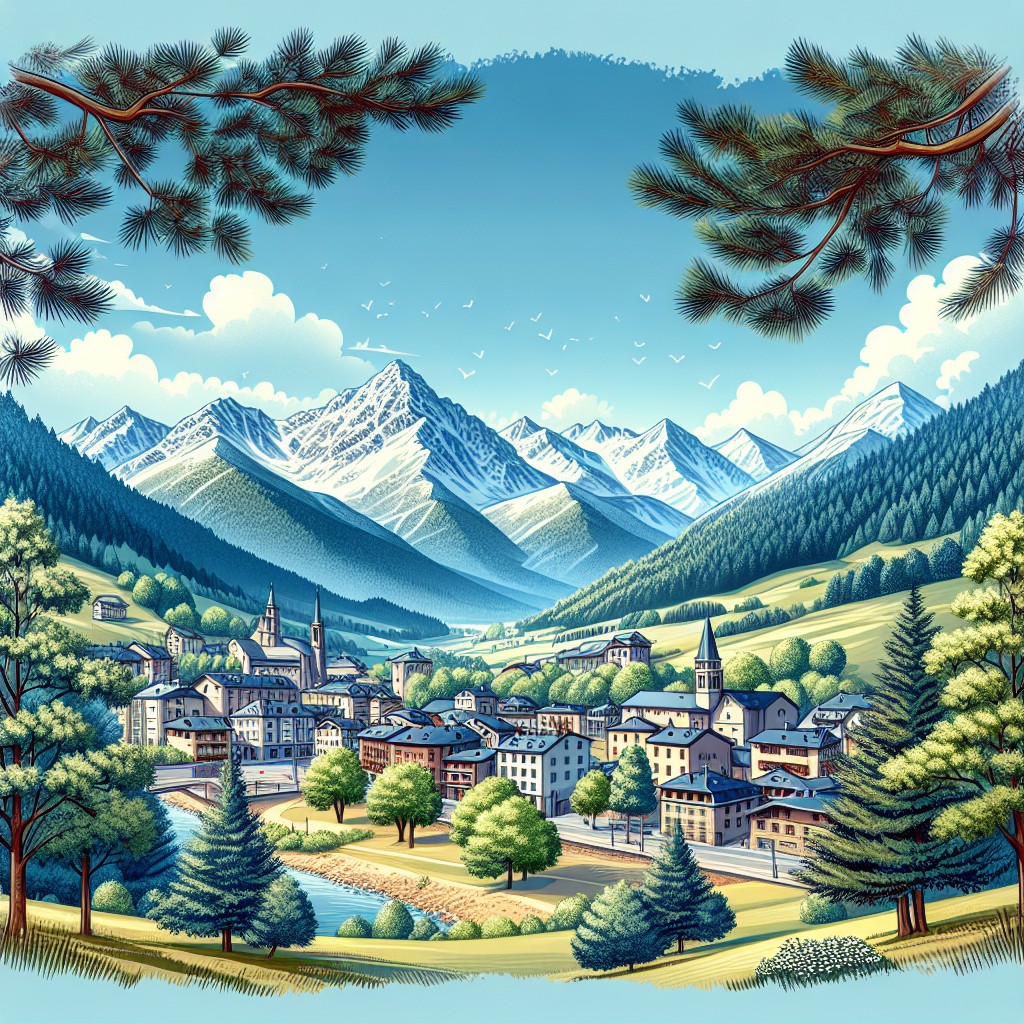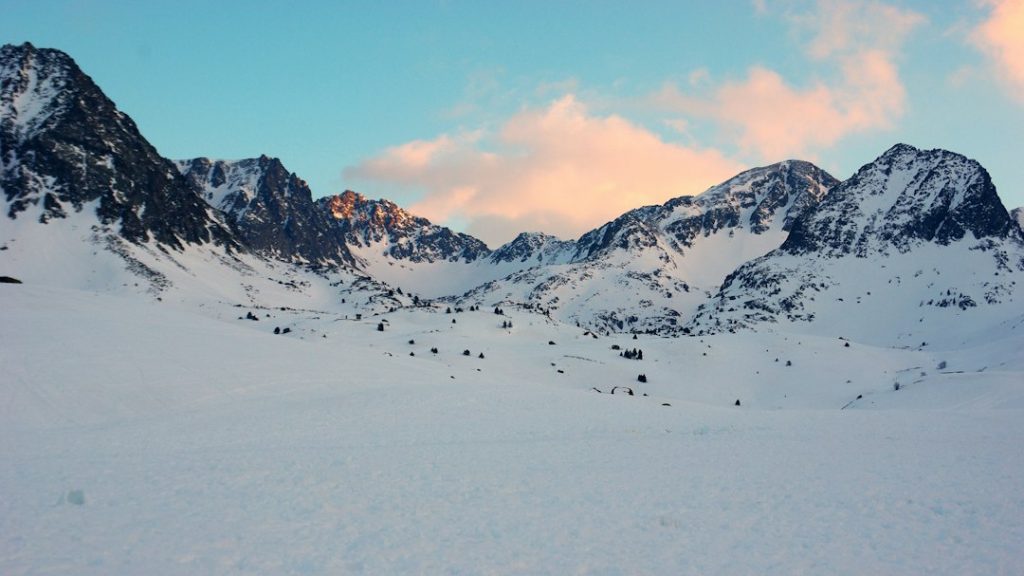Andorra, a small landlocked country nestled in the Pyrenees Mountains between France and Spain, boasts a unique terrain and topography that sets it apart from its neighboring countries. With an area of just 468 square kilometers, Andorra is one of the smallest countries in Europe. Despite its size, Andorra’s landscape is diverse and captivating, offering visitors a wide range of natural wonders to explore.
The terrain and topography of Andorra have played a significant role in shaping the country’s landscape. The country is characterized by its rugged mountains, deep valleys, expansive plains, and even glaciers. These geographical features have not only influenced the climate and vegetation of the region but also shaped the culture, history, and economy of Andorra.
Summary
- Andorra’s unique terrain and topography make it a fascinating destination for tourists.
- Mountains dominate Andorra’s landscape, with the Pyrenees connecting it to France and Spain.
- Valleys provide low-lying areas in Andorra, with the Madriu-Perafita-Claror Valley being a UNESCO World Heritage Site.
- Plains are lesser-known areas of Andorra, with the Gran Valira Valley being the main river basin.
- Glaciers add to Andorra’s frozen terrain, while its climate and vegetation are influenced by its terrain and topography.
Mountains: The Dominant Feature of Andorra’s Landscape
Mountains dominate the landscape of Andorra, with the country being home to several mountain ranges. The highest peak in Andorra is Coma Pedrosa, standing at an impressive 2,942 meters above sea level. Other notable mountain ranges include the Pyrenees Mountains, which form the natural border between France and Spain.
The mountains hold great significance in Andorra’s culture and history. They have provided a natural barrier that has protected the country from invasions throughout history. Additionally, the mountains have shaped the traditional way of life in Andorra, with agriculture and livestock farming being important economic activities for centuries.
For tourists, the mountains offer a plethora of activities to enjoy. Hiking and trekking are popular pursuits, with numerous trails crisscrossing the mountainous terrain. Visitors can also engage in mountaineering, rock climbing, and even skiing during the winter months when the mountains are blanketed in snow.
The Pyrenees: Andorra’s Connection to France and Spain
The Pyrenees mountain range is a defining feature of Andorra’s landscape. Stretching over 430 kilometers, the Pyrenees serve as a natural border between France and Spain. Andorra is nestled in the eastern part of the Pyrenees, making it a unique crossroads between the two countries.
The Pyrenees have played a crucial role in Andorra’s history and economy. The mountain range has served as a natural barrier, protecting Andorra from invasions and providing a sense of isolation that has allowed the country to maintain its independence throughout the centuries.
The Pyrenees also offer significant tourism opportunities for Andorra. The region attracts outdoor enthusiasts who come to explore the stunning landscapes, hike through picturesque trails, and engage in various adventure sports. Additionally, the proximity to both France and Spain allows for cross-border tourism, with visitors being able to explore multiple countries in one trip.
Valleys: The Low-Lying Areas of Andorra
While mountains dominate Andorra’s landscape, the country is also home to several valleys that provide a stark contrast to the rugged terrain. Valleys such as Valira d’Orient, Valira del Nord, and Valira d’Occident are low-lying areas that offer fertile land for agriculture and provide a haven for wildlife.
The valleys have been of great importance to Andorra’s agriculture and tourism industries. The fertile soil in these areas allows for the cultivation of crops such as cereals, vegetables, and fruits. Additionally, the valleys are home to numerous vineyards that produce high-quality wines.
For tourists, the valleys offer a tranquil escape from the mountains. Visitors can enjoy leisurely walks along the valley floors, taking in the breathtaking scenery and observing the diverse flora and fauna. The valleys also provide opportunities for birdwatching and wildlife spotting, with several nature reserves located in these areas.
The Madriu-Perafita-Claror Valley: A UNESCO World Heritage Site
One of the most remarkable valleys in Andorra is the Madriu-Perafita-Claror Valley, which has been designated as a UNESCO World Heritage Site. This valley is located in the eastern part of Andorra and covers an area of approximately 42,000 hectares.
The Madriu-Perafita-Claror Valley is of immense importance due to its natural and cultural heritage. The valley is home to a diverse range of ecosystems, including forests, meadows, rivers, and lakes. It also serves as a habitat for several endangered species, making it a vital conservation area.
In addition to its natural beauty, the Madriu-Perafita-Claror Valley is also rich in cultural heritage. The valley has been inhabited since prehistoric times and contains numerous archaeological sites that provide insights into the region’s history. Traditional farming practices and stone-built houses can still be found in the valley, showcasing the traditional way of life in Andorra.
Tourists visiting the Madriu-Perafita-Claror Valley can engage in a variety of activities. Hiking and camping are popular pursuits, with several well-marked trails leading through the valley. Visitors can also explore the archaeological sites and learn about the history and culture of Andorra.
Plains: The Lesser-Known Areas of Andorra
While mountains and valleys dominate Andorra’s landscape, the country also has some lesser-known plains that offer a different perspective on its terrain. The plains are located in the western part of Andorra and provide a contrast to the rugged mountainous regions.
The plains may not be as well-known as the mountains or valleys, but they play an essential role in Andorra’s economy and ecology. The flat terrain allows for easier transportation and infrastructure development, making it an ideal location for commercial activities. Additionally, the plains provide fertile land for agriculture, with crops such as wheat, barley, and potatoes being cultivated in these areas.
For tourists, the plains offer a chance to experience a different side of Andorra. Visitors can explore the rural landscapes, visit traditional villages, and learn about the agricultural practices that have sustained the region for centuries. The plains also provide opportunities for horseback riding and cycling, with several trails winding through the flat terrain.
The Gran Valira Valley: Andorra’s Main River Basin
The Gran Valira Valley is the main river basin in Andorra, stretching over 35 kilometers from north to south. The valley is formed by the Gran Valira River, which originates in the eastern part of Andorra and flows into Spain.
The Gran Valira Valley is of great importance due to its water resources. The river provides a source of freshwater for Andorra, supporting agriculture, industry, and tourism. Additionally, the valley is home to several reservoirs that store water for irrigation and hydroelectric power generation.
Tourists visiting the Gran Valira Valley can enjoy a range of activities related to water. Fishing is a popular pursuit, with the river being home to various species of trout. Visitors can also engage in water sports such as kayaking and rafting, taking advantage of the fast-flowing waters of the river.
Glaciers: Andorra’s Frozen Terrain
Although small in size, Andorra is home to several glaciers that add to its unique terrain. Glaciers are large masses of ice that form over long periods of time and shape the landscape through their movement and erosion.
The glaciers in Andorra are located in high-altitude areas and are remnants of the last ice age. While they have significantly reduced in size over the years due to climate change, they still play a crucial role in Andorra’s climate and environment.
Glaciers act as natural reservoirs, storing water that is released slowly over time. This water contributes to the flow of rivers and streams, ensuring a steady water supply for agriculture and other activities. Additionally, the melting of glaciers contributes to the formation of lakes and wetlands, which are important habitats for various species of plants and animals.
For tourists, glaciers offer a unique opportunity to witness the effects of climate change firsthand. Guided tours are available, allowing visitors to explore the icy landscapes and learn about the importance of glaciers in Andorra’s ecosystem.
Climate and Vegetation: Influenced by Andorra’s Terrain and Topography
Andorra’s terrain and topography have a significant impact on its climate and vegetation. The country experiences a mountainous climate, with temperatures decreasing as altitude increases. The mountains act as barriers, preventing the warm Mediterranean air from reaching the country’s interior.
The diverse terrain of Andorra also contributes to the wide range of vegetation found in the country. The lower valleys are home to deciduous forests, while higher altitudes are characterized by coniferous forests. Alpine meadows can be found in the mountainous regions, providing grazing land for livestock.
The climate and vegetation of Andorra offer numerous opportunities for tourists to engage in outdoor activities. During the summer months, visitors can go hiking, mountain biking, or horseback riding through the lush forests and meadows. In winter, skiing and snowboarding are popular pursuits, with several ski resorts located in the mountains.
Andorra’s Terrain and Topography as a Tourist Attraction
In conclusion, Andorra’s unique terrain and topography make it a captivating destination for tourists. The mountains, valleys, plains, glaciers, and rivers offer a diverse range of landscapes to explore. These geographical features have not only shaped Andorra’s culture, history, and economy but also provide numerous opportunities for outdoor activities.
Whether it’s hiking through the rugged mountains, exploring the tranquil valleys, or witnessing the effects of climate change on glaciers, visitors to Andorra are sure to be captivated by its natural beauty. The country’s terrain and topography serve as a magnet for tourists, attracting outdoor enthusiasts, nature lovers, and adventure seekers from around the world.
Andorra’s landscape is a testament to the power of nature and the beauty that can be found in even the smallest of countries. As visitors explore the diverse terrain and topography of Andorra, they are sure to be left with a lasting impression of its natural wonders and the unique experiences it has to offer.
FAQs
What is the terrain and topography of Andorra?
Andorra is a small landlocked country located in the Pyrenees mountains between France and Spain. The terrain is mountainous, with the highest peak being Coma Pedrosa at 2,942 meters (9,652 feet) above sea level. The country also has several valleys and plains.
What are the major mountain ranges in Andorra?
The Pyrenees mountain range runs through Andorra, with several peaks over 2,000 meters (6,500 feet) above sea level. The highest peak in Andorra is Coma Pedrosa, located in the northwest of the country.
What are the major valleys in Andorra?
Andorra has several valleys, including the Valira del Nord, Valira d’Orient, and Madriu-Perafita-Claror valleys. These valleys are home to many of the country’s towns and villages.
What are the major plains in Andorra?
Andorra has several small plains, including the Pla de l’Estany and the Pla de la Cot. These plains are located in the eastern part of the country and are used for agriculture and grazing.
What is the climate like in Andorra?
Andorra has a mountain climate, with cold winters and mild summers. The temperature can vary greatly depending on the altitude and location within the country. The average temperature in the capital city of Andorra la Vella is around 11°C (52°F).
What is the significance of Andorra’s terrain and topography?
Andorra’s mountainous terrain and location in the Pyrenees make it a popular destination for outdoor activities such as skiing, hiking, and mountain biking. The country’s valleys and plains are also important for agriculture and grazing. Additionally, the terrain and topography have played a role in shaping the country’s culture and history.


